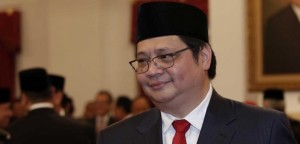Industry Ministry Welcomes Presidential Regulation on National Industrial Policy
 Minister of Industry Airlangga Hartarto welcomes Presidential Regulation Number 2 of 2018 on National Industrial Policy 2015-2019, signed by President Joko Jokowi Widodo on 2 February 2018.
Minister of Industry Airlangga Hartarto welcomes Presidential Regulation Number 2 of 2018 on National Industrial Policy 2015-2019, signed by President Joko Jokowi Widodo on 2 February 2018.
According to the minister, the Presidential Regulation is a framework for the development of Indonesian industry to improve its competitiveness in the world.
“The Government continues to create a positive investment climate as well as provide convenience for business entities to run their business in Indonesia,” the Minister said in Jakarta on Thursday (22/3).
Article 1 paragraph (2) of the Regulation stipulates that the National Industrial Policy (KIN) 2015-2019 is in line with the National Medium Term Development Plan (RPJMN) 2015-2019, and is the direction and action to achieve the goals of the first phase of industrial development in 2015-2019, in the form of the National Industrial Development Master Plan Year 2015-2035.
Hartarto explained that the objectives of this regulation include the focus of industrial development, the stage of industrial development, development of industrial resources, development of industrial facilities and infrastructure, industrial empowerment, development of priority industries and small and medium industries, development of industrial zones, and fiscal and non-fiscal facilities.
“When drafting the regulation, we always listen to the inputs from national industry players,” the Minister said, adding that some of the goals in the regulation are set to be achieved in 2019, including improving growth rate of non-oil and gas processing industry by 5.5-6.2 percent, achieving 18.2-19.4 percent contribution of manufacturing industry to the economy, and increasing the export of domestic industrial products.
“Through the Presidential Regulation, the Government also sets out industry sectors to become the mainstay of the industry in the future, including food industry, pharmaceutical industry, cosmetics and medical equipment, textile, leather, footwear, transportation equipment industry, electronics industry and telematics, and energy industry,” the Minister Hartarto said.
Furthermore, Hartarto hopes that manufacturing industry will consistently provide multiple effects for national economy: increasing the added value of domestic raw materials, absorbing a lot of employees, generating foreign exchange from exports, as well as becoming the largest contributor of taxes and custom duties. He also said that Ministry of Industry is committed to developing manufacturing industry programs.
“We dont want to continue exporting our raw natural resources without processing,” he said, adding that the manufacturing industry has achieved significant results, including agro-based products and mineral mining such as palm oil derivatives, stainless steel, and smartphone products.
Minister Hartarto further explained that growth of manufacturing value added (MVA) in Indonesia is the highest among ASEAN countries. MVA Indonesia, he said, is 4.84 percent, while in ASEAN it ranges 4.5 percent. At the global level, Indonesia is currently ranked ninth in the world, he added.
The percentage of manufacturing sectors contribution to Indonesias GDP is among the top five in the world, outperforming Japan, India, and the United States. Furthermore, Indonesian economy has entered one trillion-dollar club, or one third of the value of ASEAN economy,” the Minister concluded.
(SM/Humas Kemenperin/ES) (RI/EP/Naster)








